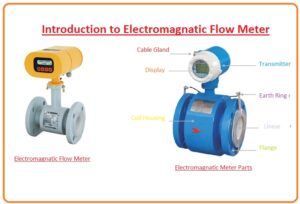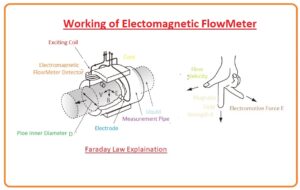 This flow meter is a transducer device that processes liquid flow by the voltage induced crossways the fluid by its movement through a magnetic field. A magnetic field is delivered to the gaging tube, which possessions in a potential difference proportionate to the flow velocity vertical to the flux outlines. The principle at it work is Faraday’s law of electromagnetic induction. Which states that rate of change of flux is directly proportional to the induced voltage.
This flow meter is a transducer device that processes liquid flow by the voltage induced crossways the fluid by its movement through a magnetic field. A magnetic field is delivered to the gaging tube, which possessions in a potential difference proportionate to the flow velocity vertical to the flux outlines. The principle at it work is Faraday’s law of electromagnetic induction. Which states that rate of change of flux is directly proportional to the induced voltage.
The magnetic flow meter needs a conducted fluid, for example, water that comprises of ions, and an electrical protecting pipe superficial, for example, a rubber-lined steel tube. If the magnetic field course were persistent, electrochemical and other properties at the probes would make the potential difference hard to differentiate from the liquid flow persuaded potential difference. To alleviate this in present magnetic flowmeters, the magnetic field is continually upturned, stopping out the electrochemical potential difference, which does not alter the way with the magnetic field. This nevertheless stops the usage of permanent magnets for magnetic flowmeters. In this article, I will explain details about its employed, principle, equation etc. So let’s get started with the introduction to the Magnatic flow meter.
Introduction to Magnetic Flow Meter
- A magnetic flow meter is a transducer device that processes liquid flow by the voltage induced crossways the fluid by its movement through a magnetic field. A magnetic field is provided to the measuring tube, which affects in a potential difference proportionate to the flow velocity vertical to the flux outlines.
- Magnetic flowmeters calculate the speed of conductive fluids in pipes, like water, acids, corrosive, and slurries. Magnetic flowmeters can measure correctly when the electrical conductivity of the fluid is superior to about 5μS/cm. Be cautious since using magnetic flowmeters on liquids with little conductivity, such as deionized water, cistern fodder water, or hydrocarbons, can cause the flowmeter to go off and measure zero flow.
- This flowmeter does not hinder flow, so it can be pragmatic to unsoiled, hygienic, muted, eroding and rasping fluids. Magnetic flowmeters can be pragmatic to the flow of fluids which are conductive, so hydrocarbons and gases cannot be calculated by this equipment due to their non-conductive landscape and vaporous formal, correspondingly.
- Magnetic flowmeters do not need abundant upstream and downstream conventional runs so they can be connected in comparatively small meter runs. Magnetic flowmeters characteristically need 3-5 breadths of upstream traditional run and 0-3 diameters of downstream straightforward run measured from the smooth of the magnetic flowmeter electrodes.
- Submissions for muted fluids originate in the water, wastewater, quarrying, inanimate dispensation, power, mash and paper, and chemical diligence. Water and wastewater requests contain supervision transmission of fluids in force mains between water/wastewater regions. Magnetic flowmeters are used in water action floras to measure preserved and crude manure, course water, water and chemical flows.
- With good care to ingredients of assembly, the flow of extremely eroding fluids (such as acid and corrosive) and harsh slurries can be dignified. Eroding fluid requests are usually created in the chemical industry procedures, and in chemical food schemes used in maximum activities. Slurry requests usually establish in the mining, inorganic dispensation, mash and paper, and wastewater activities.
- Magnetic flowmeters are frequently used wherever the fluid is nursed using gravity. Be sure that the direction of the flowmeter is such that the flowmeter is entirely filled with fluid. Catastrophe to confirm that the flowmeter is entirely full with runny can meaningfully disturb the flow measurements.
- Be particularly cautious when working magnetic flowmeters in space provision since some magnetic flowmeter inserts can breakdown and be drunk into the tube in a vacuum facility, disastrously harmful the flowmeter. Note that vacuum circumstances can happen in piping that apparently is not unprotected to vacuum provision such as pipes in which a gas can abbreviate (often underneath irregular circumstances). Likewise, the unnecessary temperature in magnetic flowmeters (even fleetingly beneath irregular circumstances) can result in enduring flowmeter impairment.
Working of Magnetic flow Meter
- The process of a magnetic flow mete is centered upon Faraday’s Law, which explains that the voltage induced crosswise by any conductor as it transfers at right angles over a magnetic field is proportional to the speed of that conductor.
- As pragmatic to the enterprise of magnetic flow meters, Faraday’s Law designates that signal voltage (E) is reliant on the typical fluid velocity (V) the magnetic field (B) and the length of the conducting material (D) (which in this illustration is the distance amid the electrodes).
According to Faraday law
E is proportionate to V * B * D where:
E = The voltage produced in a conductor V = The speed of the conductor B = The magnetic field strength D = The length of the conductor
- To smear this principle to movement measurement with a magnetic flow meter, it is essential first to explain that the liquid being dignified should be electrical conducive for the Faraday principle to relate.
- As pragmatic to the enterprise of magnetic flow meters, Faraday’s Law designates that signal voltage (E) is reliant on the average fluid velocity (V) magnetic field (B) and the length of the conductor (D) (which in this illustration is the distance amid the electrodes).
- In the circumstance of wafer-style magnetic flow meters, a magnetic field is recognized through the complete cross-section of the flow tube. If this magnetic field is deliberated as the measuring component of the magnetic flow meter, it can be understood that the measuring component is uncovered to the hydraulic circumstances through the complete cross-section of the flow meter. With insertion-style flow meters, the magnetic field releases the outer from the implanted leads.
Types of magnetic flow meter
In line Magnetic Flowmeter
- These gainful magnetic flow meters syndicate larger sound resistance with high transparency Alumina earthenware recognition tubes, permitting exact flow measurements in a varied range of submissions.
- These magmeters are accessible in pipe dimensions from 1 /2 ” up to 16″ to lodge many ingredients such as chemicals, eroding, nourishments, mash and other solid substance slurry movements.
- The FMG-600 Sequences electromagnetic flowmeter distinctive sound-destruction circuitry uses the finest square-waved excitation frequency, removing numerous sounds produced by slurries, which makes this flowmeter the perfect option for pulp, nourishment and plaster submissions.
Insertion style flow meter
- The FMG-550 Sequence fits pipe dimensions from 2 to forty-eight inches. The normal assembly is a 1¼ inches NPT.
- It structures an essential demonstration for movement rate or tantalization. The newest in bipolar beat dc expertise and the finest landscapes of an enclosure magnetic flow meter instrument are filled into the FMG-550 Sequence addition magmeter.
- The FMG-551 is a magnetic flow meter to encounter your flow quantities experiments. Modest fitting, tranquil preservation, and state-of-the-art microprocessor expertise sort the FMG-551 as the best substitute to outdated full-line magmeters.
- The FMG-551 electromagnetic flowmeter makes a remote current output and insulated frequency productivity. The current output delivers a worldwide sign to plotters, regulators, and a horde of procedure regulator and data attainment strategies.
- The FMG3000 and FMG3100 Sequences are for 0.5 to 8 inch Pipes. These are sightless spreaders with any 4 to 20mA or frequency yield. All forms of this magmeter are built of corrosion-resistant ingredients to deliver long-term dependability with negligible maintenance prices.
Low Flow Magmeter
- The FMG201 Sequence is a minor plastic-bodied magnetic flow meter accomplished of gaging the effervescent movements from air and solenoid-obsessed metering propels, the meter is mainly intended for electrical-conductive substances and liquids of variable viscosities.
- The FMG201 electromagnetic flowmeter is a perfect flow dimension expedient for little flow submissions. In adding to gaging and exhibiting flow rate and entire flow, this magmeter component has a diversity of outputs.
- For the incessant broadcast of a movement signal, there is a 4 to 20 mA, and 0 to a 5-volt pointer, and a frequency is proportionate to flow. In adding, there are communicate alarm outputs for small and extraordinary flows with operator set flow points.
Precautions for Magnetic Flowmeters
- Do not activate a magnetic flowmeter nearby its electrical conductivity perimeter since the flowmeter can stop working. Deliver a stipend for altering configuration and working circumstances that can alter the electrical conductivity of the fluid.
- In distinctive requests, magnetic flowmeters are sized so that the speed at supreme flow is about 2-3 meters per second. Difference pressure restraints or process situations can prevent the submission of this overall advice.
- For example, gravity nursed pipes may need a greater magnetic flowmeter to decrease the pressure descent so as to permit the obligatory quantity of fluid to permit through the magnetic flowmeter deprived of assistance up the piping scheme. In this presentation, functioning at a similar flow rate in the greater flowmeter will consequence in an inferior liquid velocity as associated to the lesser flowmeter.
- For slurry provision, be certain to the extent magnetic flowmeters to function overhead the speed at which objects resolve (naturally 1 ft/sec), in order to evade satisfying the pipe with objects that can disturb the dimension and possibly end flow.
- Magnetic flowmeters for scratchy facilities are typically sized to work at little speed (characteristically below 3 ft/sec) to decrease garb. In the rasping slurry facility, the flowmeter should function overhead the velocity at which objects will resolve, despite improved attire. These subjects may alteration the range of the flowmeter, so its extent may be dissimilar to the extent for a corresponding flow of freshwater.
- The contiguous technology to Publication that might perhaps grip alike solicitations extra cost-efficiently would be vortex shedding. They can grip light particulate, have an advanced pressure droplet, inferior range aptitude, and are somewhat fewer precise.








